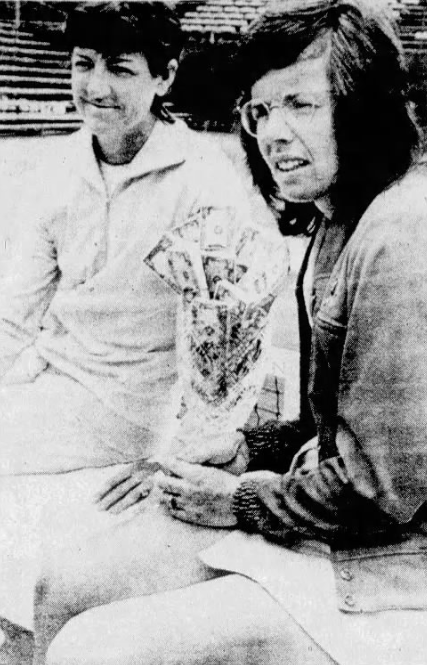
“In tennis,” said a Philip Morris staffer involved with the company’s sponsorship of the women’s game, “it seems like it takes three to tango.”
Quite a challenge, he might have added, when two of them despise each other.
When the Open era began in 1968, the sport’s governing bodies made it clearer than ever that women’s tennis was not a priority. Many tournaments went men-only, and equal prize money was a pipe dream. In September 1970, the “Original Nine” women players, managed by magazine publisher Gladys Heldman and supported by Joseph Cullman of Philip Morris, struck out on their own. Independence was the only possible path to respect.
By 1973, the Philip Morris-backed Virginia Slims tour was a thriving concern. Tennis boomed as both a spectator sport and a recreational activity for men and women alike. The women still relied on Cullman’s support, but the tour’s stops around the United States–led by stars such as Billie Jean King and Margaret Court–were major events, drawing thousands of fans.
The USLTA belatedly realized what it was missing. Just a few years earlier, the organization had put women’s stars on outside courts and signed off on prize money distributions that sometimes gave men nine-tenths of the pot. Now, it scrambled to organize a women-only circuit. With a combination of financial inducements, appeals to personal loyalty, and threats–the Slims tour was non-sanctioned, after all–the USLTA attracted a decent slate of players.
The mud-slinging began even before the first ball was struck. The US federation had the power to ban American players from events such as the US Open. Now with its own tour, the USLTA served warning that it might do just that. Heldman filed suit in January, charging an “illegal trade boycott,” among many other offenses.
“Heldman” became a dirty word in USLTA circles. But the real victims were tennis fans. Both Slims and USLTA events could be outstanding: The Slims didn’t lack for stars, and the presence of young Chris Evert on the federation circuit guaranteed a solid turnout at every stop. Yet the events paled in comparison to what could have been. Neil Amdur of the New York Times wrote that the divide “saddled both circuits with watered-down player draws and produced dull, often routine first-round matches.”
Marilyn Fernberger, a long-time tournament promoter in Philadelphia, was more direct. “The girls have to get together,” she said. “They’re not strong enough to make it alone. If they don’t, they’ll only hurt themselves and women’s tennis in the long run.”
Little progress was made until April, when the stakes rose even higher. The ILTF, the international governing body that worked closely with national associations, said that it would ban all Slims players–not just the Americans–from federation-run events around the world. King, Court and the rest would be suspended from Wimbledon, the US Open, and every other notable tournament for the rest of 1973.
A reporter asked King what she would do if the ILTF blocked her from entering Wimbledon. Well, she said, she’d probably have to sue.
In the end, the whole kerfuffle was shown to be nothing more than a cash grab. The three sides–the USLTA, Philip Morris as the backer of the Slims tour, and the players–sat down on April 27th. The outline of a deal was quickly reached: Philip Morris would pay $20,000 to the federation in lieu of sanction fees. No players would be suspended. The tours would continue to operate as planned over the summer, and Heldman would manage a combined circuit after the US Open.
The players made it official when they okayed the deal on April 30th. They met the ILTF’s deadline, so they could compete in Europe over the summer. Billie Jean, in particular, was relieved. As the lead player representative, she had faced the stress of the circuit’s legal situation at the same time that she promoted the tour and attempted to win a title every week. Now she could head to Hilton Head, South Carolina, and compete for a record-setting $30,000 winner’s check at the inaugural Family Circle Cup.
Arthur Ashe had been through similar struggles in the men’s game. In mid-April, a reporter asked him about the Slims situation. “There has to be cooperation, a meeting of the minds,” Ashe said. “The sport has never been this big before. So everyone is going to have to have that spirit of cooperation and pull together. There’s enough for everybody.”
So it proved–especially once the federation got out of the way.
* * *
This post is part of my series about the 1973 season, Battles, Boycotts, and Breakouts. Keep up with the project by checking the TennisAbstract.com front page, which shows an up-to-date Table of Contents after I post each installment.
You can also subscribe to the blog to receive each new post by email: